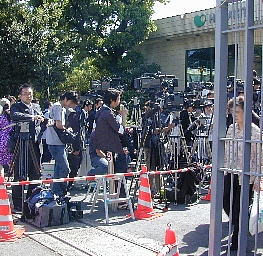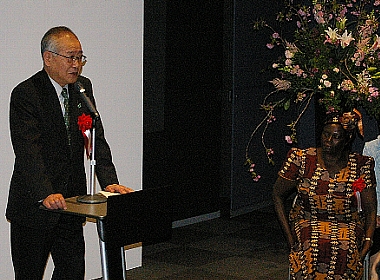|
The registration form
NSK News Bulletin Online
June 2007 -------------------------------------------------------------------
*Topics --NEWSPARK Runs Special °∆Mottainai°« Campaign Exhibition - - - - - - - - - - - - - - - - - - - - - - - - - - - - - - - - - - - - - - Story of the Month>>> Sankei Launches Page-Linked Advertising ------------------------------------------------------------------- Farm Minister°«s Suicide Prompts Extras, Follow-Up Editions Agriculture Minister Toshikatsu Matsuoka, 62, was found hanging himself at his Tokyo apartment at 12:20 pm on May 28, and was pronounced dead at 2 p.m. after being rushed to a hospital. Major newspapers issued extras and follow-up evening editions to report on Matsuoka, who had been embroiled in a political funds scandal. He is the first Cabinet minister to commit suicide since World War Two. The Asahi Shimbun issued a follow-up edition to its regular 4th evening edition. Its West Japan head office delivered about 1,000 copies to Kumamoto, Matsuoka's hometown. The Yomiuri Shimbun issued a follow-up to its 3rd evening edition. The Asahi also issued a color 2-page extra of which it distributed 72,000 copies from its Tokyo, Osaka and Hokkaido head offices. The Yomiuri Shimbun issued 34,000 2-page color extras from its Osaka, Central Japan and Hokkaido head offices. The Mainichi Shimbun issued 20,000 single-page color extras from its Tokyo, Central Japan and Hokkaido head offices, and the Sankei Shimbun distributed 10,000 2-page extras from its Osaka head office. According to a Kyodo News survey, 13 regional and local newspapers issued extras, while other newspapers issued follow-up evening editions or special editions after the day°«s last regular editions. In Kumamoto Prefecture -- the farm minister's home prefecture -- the Kumamoto Nichi-nichi Shimbun issued a 1-page color extra, distributing 13,000 copies at key places in the minister°«s electoral district, including Aso City and main railways stations, shortly after 3 p.m. The paper also issued a follow-up evening edition. Reporters and photographers gathered after 1 p.m. at Matsuoka°«s office in the House of Representatives°« No. 1 Diet Members°« Building. Matsuoka was found in cardiac and pulmonary arrest at his unit in the Diet Members°« apartments in Tokyo°«s Akasaka district. He was taken to Keio University Hospital in Shinanomachi. By chance, a number of reporters and news photographers were already at the university hospital, reporting on the accidental death of a pop star singer the previous day. Upon the news of Matsuoka°«s suicide, newspapers sent journalists to the Diet Members°« building and apartments. By 2:30 p.m., more than 40 reporters and 10 photographers had gathered beside the front gate of the hospital (see photo), and 30 more reporters stood in front of the gate. After 3 p.m., hospital authorities banned all photography within the hospital compound to protect patient privacy. Nikkei Hosts °∆Future of Asian Media°« Symposium Nikkei Inc. on May 23 hosted an international symposium on °»the Future of Asian Media°…. Starting with keynote speeches by executives of major South Korean and Chinese newspapers, the participants attended a panel discussion on °»the prospects for competition and collaboration among media organizations in Asia°…. The panel generated heated debate on the role of newspapers in the Internet era and the need to deliver more information from Asia to the United States and Europe. In his keynote speech, Seok Hyun HONG , the chairman and CEO of JoongAng Ilbo, a leading South Korean daily, said the sheer volume of news on the Internet is so massive that it has become tantamount to getting no information at all. He said only a group of professional journalists with many years of experience would be qualified to analyze and prioritize the most important news. He said his own newspaper aims to deliver not only straight news, but also information incorporating in-depth analysis. Other panel members included Ryoki Sugita, the president and CEO of Nikkei Inc., Li Ruigang, the president of Shanghai Media Group, and Han Fook Kwang, the editor of The Straits Times of Singapore. Yuichi Takahashi, the director & editor-in-chief of the Nikkei°«s Tokyo head office, acted as moderator. The Straits Times' Han said newspapers can and do compete head on with the °»new media°… by providing reliable articles that strike a familiar chord with readers. The Nikkei°«s Sugita said online media boast real-time delivery, interactivity and visual effects, adding that the Nikkei plans to launch an electronic newspaper in two years. According to Sugita, the electronic newspaper will feature live links to related information, like an °»a la carte°… menu, and will be distributed via digital TV and other means. He said the online newspaper will be designed to generate earnings through advertising and user access charges. The panelists agreed that the West needs to get more news and information from an Asian perspective. Shanghai Media°«s Li said his group broadcasts a 5-minute English economic program four times a day to the United States by satellite via CNBC TV of the United States. The JoongAng Ilbo's Hong said global demand is soaring for economic info from Northeast Asia. He proposed linking English-language Web sites of major newspapers in the region as a base of information for transmission to the world. Nikkei°«s Sugita said that despite varied cultural and customs, the world is filled with information positioned from a Western perspective. He called for more efforts by Asian media to present the Asian way of thinking to the Western world. Asahi Marks 20 Years Since Kobe Reporter's Killing On May 3, 1988, a suspected rightwing extremist carrying a shotgun entered the Asahi Shimbun's Hanshin bureau and fatally shot reporter Tomohiro Kojiri, who was 29. A fellow reporter was seriously wounded. Asahi President Kotaro Akiyama and 80 others observed a moment of silence at the memorial library dedicated to the slain reporter. They gathered on the third floor of the Asahi's Hanshin branch in Nishinomiya, Hyogo Prefecture, at 8:15 p.m. on May 3, the exact time of the attack nearly two decades ago. Over 600 people visited the library through the day to honor the slain journalist at a memorial altar. The Asahi's May 1 issue carried an editorial titled °»The Pen Will Never Succumb to Terrorism°… and reiterated the paper's pledge to fight terrorism, stating °»We abhor and decry violence and will never let it prevail over the might of the pen.°… The Asahi's May 1 editorial complained of continuing terror attacks on the media since World War Two, despite the constitutional guarantee of freedom of the press. It emphasized the importance of having the media make a careful response to violence and of having the media carry politicians' and business leaders' condemnations of all terrorist acts. In a lead-up event on April 28, the newspaper held a talk show on freedom of the press in Nishinomiya City, Hyogo Prefecture. In addition, the memorial library at the Hanshin branch featured a special exhibition from April 28 to May 3. A special exhibition on freedom of speech featured about 80 copies of newspaper articles and photographs on violence against free speech, including the 1990 shooting attack on then Hiroshima Mayor Hitoshi Motojima. The exhibit showed, for the first time, the heavily bloodstained jacket that the Asahi reporter was wearing when he was shot. Turnout for the six-day event exceeded 1,000. Kazuo Matsuura, the chief of the Hanshin branch, said he felt growing public interest in the issue of freedom of the press. The April 28 talk show, titled °»Now Is the Time to See, Hear and Speak Out,°… is part of a series launched in 1987 marking Newspaper Week and addressing key issues related to free speech. Freelance journalist Shoko Egawa and Toshio Usui, the deputy editor-in-chief of Asahi°«s Tokyo head office, held a discussion on the issue before an audience of 300. Egawa called on newspapers and citizens to outspokenly condemn any assault on the freedom of the press. The Asahi°«s Usui recalled that after the terror attack on his newspaper, all Asahi reporters were determined to find the attacker, despite worries that he might still be armed and dangerous. Usui said he now believes that the best way for journalists to fight terrorism is to collect news and keep on writing articles matter-of-factly, just as they did before the attack on the newspaper office. Commenting on Japanese media today, Egawa warned of a trend of silence among media people. She complained that those who criticize Japan over the wartime comfort women issue are branded as °»pro-China apologists.°… °»I'm in awe about this strange air in today°«s Japanese society,°… she said. Egawa urged the media to speak up whenever freelance journalists are attacked by terrorists in a general °»attack against freedom of the press.°… She also called on people at large to give their all-out support to prevent violence.
|
||||||||||||||||

